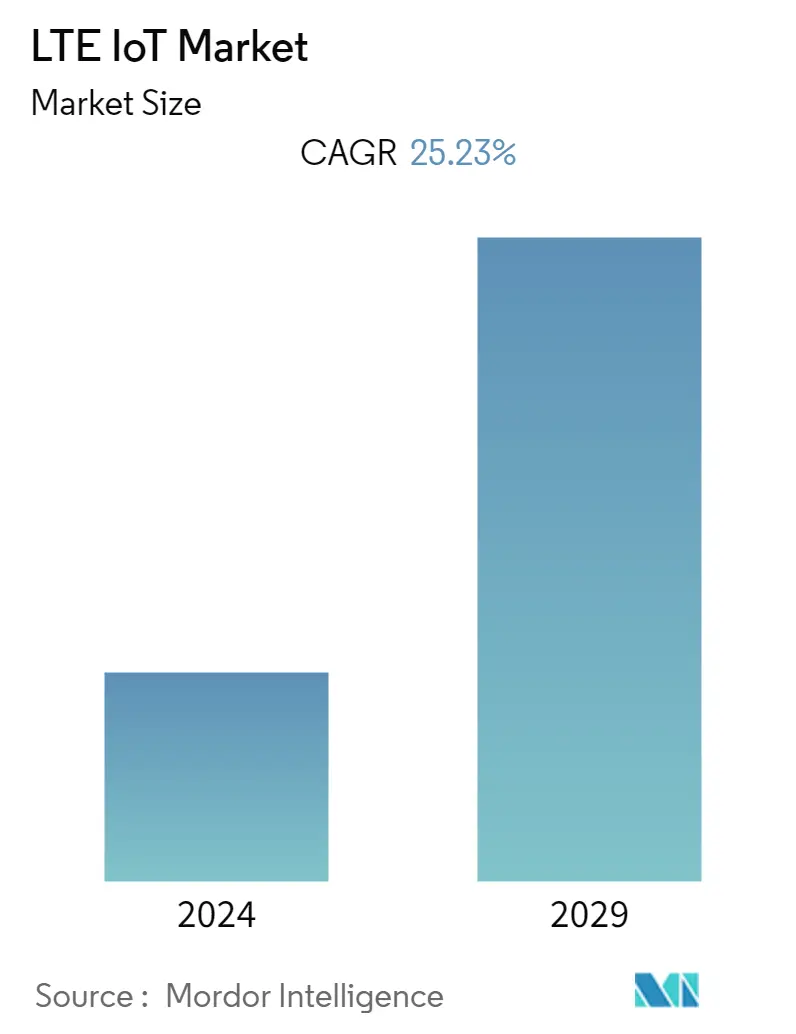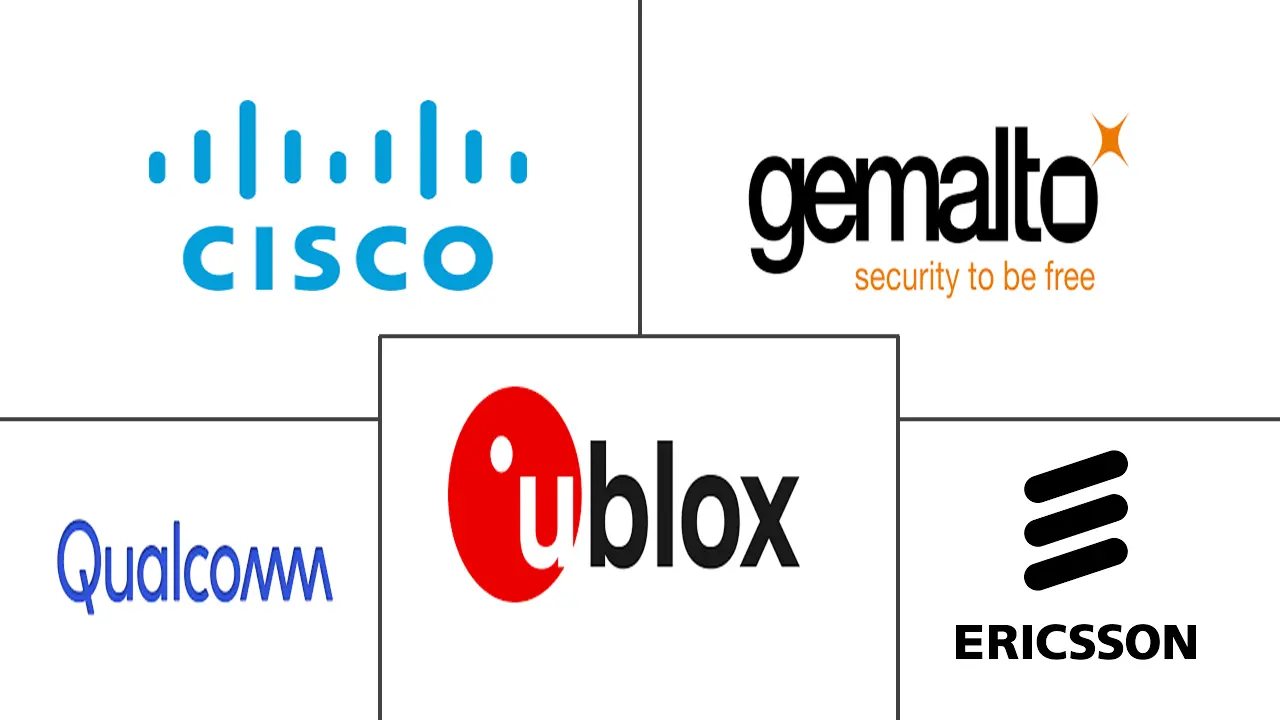Market Size of LTE IoT Industry

| Study Period | 2019 - 2029 |
| Base Year For Estimation | 2023 |
| CAGR | 25.23 % |
| Fastest Growing Market | Asia Pacific |
| Largest Market | Europe |
| Market Concentration | High |
Major Players
*Disclaimer: Major Players sorted in no particular order |
LTE IoT Market Analysis
LTE IoT Market will register a CAGR of over 25.23% during the forecast period. The growth of connected devices and the need for unique and defined network qualities fuel the development of the LTE IoT market.
- The managed service provider offers customers comprehensive and cost-effective solutions, thereby delivering their expertise in handling various operating activities (including infrastructure management, security operations, and cloud operations) to clients, enabling them to launch multiple Machine-to-Machine (M2M) offerings.
- Due to the delicate nature of manufacturing operations, manufacturers are adopting IoT solutions, sensors, and wireless connectivity platforms to increase their productivity, transforming their operations into smart manufacturing.
- Many software and solution providers offer industries smart manufacturing applications that include proactive and automatic analytics capabilities, making industrial manufacturing an intelligent and self-manageable environment. The LTE technology is availed to establish stable connectivity among various devices in a factory for data transmission, to enable industries to tackle the issues related to predictive maintenance and autonomous production.
- However, the market observed highly region-specific challenges. The enterprises demanding to deploy an IoT project within the United States have to be based on the LTE-M network due to the predominant presence of LTE radios. LTE CAT M1 devices' presence in Asia, Africa, and Eastern Europe is because mobile network operators still use 3G connectivity. However, NB-IoT devices can be found in abundance across Asia, especially in China, due to the presence of low-cost device manufacturers.
- The spread of COVID-19 has impacted many sectors that are the main markets for LTE IoT technology. The construction sector is witnessing a slower growth rate due to COVID; many running projects need to be stalled or canceled. This stops the further installation of IoT devices, such as smart street lights, meters, and parking meters. Moreover, the pandemic also affected the consumer and retail market; the sales of smart devices and smart appliances declined. All these devices actively use NB-IoT Chipset.
LTE IoT Industry Segmentation
Companies are actively working on IoT along with its high growth opportunities in multiple verticals across the market, ranging from healthcare to energy utilities and from automotive to robotics. The size of the 3GPP ecosystem is projected to further drive the commercialization of IoT, with mobile operators, infrastructure suppliers, chipset and module manufacturers, device companies, and development and testing houses supporting new services. In turn, this pushes operators to provide broadband solutions on both mobile networks under the scope of LTE-M and NB-IoT, thereby defining and creating new bundle plans with the help of combined mobile and fixed services.
The LTE IoT Market is segmented by Service (Professional, Managed), Product Type (NB-IoT, LTE-M), End-user Industry (IT & Telecommunication, Consumer Electronics, Retail (Digital Ecommerce), Healthcare, Industrial), and Geography (North America, Europe, Asia-Pacific, and Rest of the World).
The market sizes and forecasts are provided in terms of value (USD million) for all the above segments.
| By Service | |
| Professional | |
| Managed |
| By Product Type | |
| NB-IoT (Cat-NB1) | |
| LTE-M (eMTC Cat-M1) |
| By End-user Industry | |
| IT & Telecommunication | |
| Consumer Electronics | |
| Retail (Digital Ecommerce) | |
| Healthcare | |
| Industrial | |
| Other End-user Industries |
| By Geography | |
| North America | |
| Europe | |
| Asia-Pacific | |
| Rest of the World |
LTE IoT Market Size Summary
The LTE IoT market is experiencing significant growth, driven by the increasing proliferation of connected devices and the demand for specialized network capabilities. Managed service providers are playing a crucial role by offering comprehensive solutions that encompass infrastructure management, security, and cloud operations, enabling the deployment of various Machine-to-Machine (M2M) applications. Industries are increasingly adopting IoT solutions, sensors, and wireless connectivity to enhance productivity and transform operations into smart manufacturing environments. The LTE technology facilitates stable connectivity among devices, addressing challenges related to predictive maintenance and autonomous production. However, the market faces region-specific challenges, with varying adoption rates and technological preferences across different regions, such as the predominance of LTE-M networks in the United States and the widespread use of NB-IoT in Asia.
Europe is emerging as a key player in the LTE IoT market, with widespread adoption of LTE technology for IoT applications across various industries. The presence of prominent companies and ongoing developments in the region are fueling market growth. The European Commission and member states are actively supporting the deployment of IoT telecom services, with significant contributions from countries like Germany, the UK, and France. The market is highly consolidated, with major players dominating, but new entrants are expanding their presence in emerging economies. Recent collaborations and product launches, such as those by Aeris Communications, Ericsson, and Qualcomm, are enhancing IoT connectivity and solutions, driving digital transformation across industries.
LTE IoT Market Size - Table of Contents
-
1. MARKET INSIGHTS
-
1.1 Market Overview
-
1.2 Industry Attractiveness - Porter's Five Force Analysis
-
1.2.1 Bargaining Power of Suppliers
-
1.2.2 Bargaining Power of Consumers
-
1.2.3 Bargaining Power of Entrants
-
1.2.4 Intensity of Competitive Rivalry
-
1.2.5 Threat of Substitute Products
-
-
1.3 Technology Snapshot
-
1.3.1 Private LTE
-
1.3.2 Commercial LTE
-
1.3.3 Enterprise LTE
-
-
-
2. MARKET SEGMENTATION
-
2.1 By Service
-
2.1.1 Professional
-
2.1.2 Managed
-
-
2.2 By Product Type
-
2.2.1 NB-IoT (Cat-NB1)
-
2.2.2 LTE-M (eMTC Cat-M1)
-
-
2.3 By End-user Industry
-
2.3.1 IT & Telecommunication
-
2.3.2 Consumer Electronics
-
2.3.3 Retail (Digital Ecommerce)
-
2.3.4 Healthcare
-
2.3.5 Industrial
-
2.3.6 Other End-user Industries
-
-
2.4 By Geography
-
2.4.1 North America
-
2.4.2 Europe
-
2.4.3 Asia-Pacific
-
2.4.4 Rest of the World
-
-
LTE IoT Market Size FAQs
What is the current LTE IoT Market size?
The LTE IoT Market is projected to register a CAGR of 25.23% during the forecast period (2024-2029)
Who are the key players in LTE IoT Market?
Qualcomm Technologies, Inc, Gemalto N.V., u-blox AG, Telefonaktiebolaget LM Ericsson and Cisco Syatem Inc. (Jasper) are the major companies operating in the LTE IoT Market.

